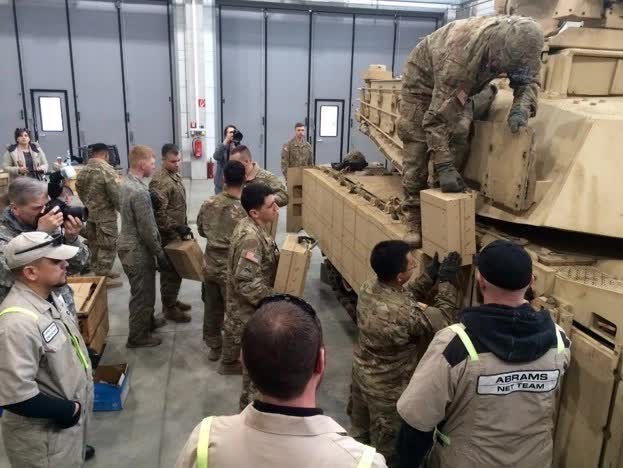Upgrade aims to slim down the insanely heavy Abrams tank
- By Hope Seck
Share This Article

A new contract decision is moving the U.S. military’s world-class Abrams tank in a direction it’s never gone before: after decades of getting bulkier amid upgrades to add firepower and cutting-edge protection, it’s finally getting a critically needed slim-down.
Defense News was first to report at the end of May that the Army had awarded a contract to Abrams manufacturer General Dynamics Land Systems (GDLS) to start developing requirements for what it’s calling the M1E3 – a new generation of Abrams tank. Reached for details on the contract, GDLS referred all questions to the Army’s PEO Ground Combat Systems, which did not respond to Sandboxx News’ queries. While the Defense Department published award notices for several smaller Abrams contract modifications in May, it appears the details of this design contract have not yet been made public.
This begins a new era of development for the Abrams, and the first of its kind in decades: the last full M1A2 rolled off production lines in 1996. Yet, the task of rolling out a modernized tank – one that needs to cut more than 10 tons from its fighting weight – is formidable.
The M1A2 Abrams is in a weight class of its own among the world’s leading tanks: the current variant, the SEPv3, weighs around 70 tons on its own, and up to 78 with a full combat load. As a comparison point, 78 tons is also the maximum takeoff weight for the Airbus A320, a passenger aircraft with a capacity for 180 souls. The heft of the Abrams tank has enabled its dominance as one of the most formidable main battle tanks in service; but as its weight has grown with each update, it has also started to limit its mobility.
Related: Special Forces engineers are training to dig ditches and destroy tanks

In 2017, a three-star Army general revealed to Congress that the tank could no longer be towed by the Heavy Equipment Transport vehicle specifically designed to tow it – meaning there was nothing that could haul the Abrams around Europe, where a number had been positioned as part of an initiative to deter Russia. Bridges are also a problem, particularly in Europe where many crossings are old and not reinforced; there, a single Abrams represents a major structural threat. With a current hot conflict in Europe, these drawbacks were increasingly concerning to planners. In September, the Army announced it was canceling a planned upgrade – the M1A2 Sepv4 – that threatened to fatten the Abrams even more, and instead pursue a more radical modernization.
“The Abrams tank can no longer grow its capabilities without adding weight and we need to reduce its logistical footprint,” Maj. Gen. Glenn Dean, program executive officer for the Army’s Ground Combat Systems, said in a statement accompanying the announcement. “The war in Ukraine has highlighted a critical need for integrated protections for soldiers, built from within instead of adding on.”
To this end, the Army is asking for $246 million for the next fiscal year, with plans to spend another $366 million on tank upgrades in fiscal 2026. A paper developed by the Congressional Research Service lays out the Army’s primary objectives for modernization. It cites a 2019 Army Science Board study that reportedly influenced the path the service is currently on. Some of them would merely adopt technologies already in use by other premier tanks, such as an autoloader, which might allow the Abrams to employ a crew of three instead of four and cut down on manpower. The French Leclerc and South Korean K2 Black Panther already have autoloaders, as do Russian, Japanese, and Chinese tanks. Also proposed is a new main gun in lieu of the Abrams’ legacy 120mm L/44 M256 smoothbore armament.
Other proposed features would enhance the Abrams’ stealth; these include “masking” tech that reduces thermal and electromagnetic signatures and a hybrid-electric drive, a feature that typically enables silent standby mode.
General Dynamics’ AbramsX demonstrator, incorporated many of these features. It built in the autoloader and the hybrid drive and swapped in an XM360 tube on the main gun to cut the weapon’s weight in half.
Related: The M1A3 Abrams and the upcoming Western tanks of the future

In addition to other wish-list features, like better command-and-control capabilities and the ability to launch drones and network with unmanned and robotic systems, the AbramsX purportedly achieves the all-important slimdown the Army wants, weighing in at a comparatively svelte 60 tons. It achieves much of these savings by relocating the crew inside the hull, allowing for a major armor reduction on the turret.
And herein lies the biggest challenge for the Army in its quest for a lighter tank: the bulkiest features the Abrams sports are the armor and protective systems that make it so formidable. The Abrams Reactive Armor Tiles that cover the tank’s surface alone add two more tons of weight – but the tiles effectively blast incoming rockets away from the vehicle’s surface, adding a next-level layer of protection.
The Abrams’ Trophy Active Protection System, an Israeli-developed countermeasure that detects and intercepts incoming threats much like a miniature Iron Dome, adds nearly four more tons. That reality has spurred speculation as to whether Trophy will be featured on future generations of the Abrams.
The reality is that the M1 Abrams has gotten so heavy through its cycle of adding new protections onto its rugged frame as they become state-of-the-art: therefore, it is a cross-section of many of the best systems the world’s tanks have to offer. To cut weight, the Army will have to undertake an aggressive redesign to make some of those systems internal to the vehicle; but it may also have to make some tough tradeoff decisions about what the next-generation Abrams truly needs to meet tomorrow’s threats.
It is left to be seen which features belong in Abrams’ future, and which will be left in the past.
Read more from Sandboxx News
- Hotchkiss Type Universal aimed to become a paratrooper’s best friend
- 5 books about US special operations forces that should be made into movies
- Russia has started using a new destructive bomb in Ukraine
- The toasted-bread standoff: Keeping honest men honest
- US Navy nuclear ballistic missile submarine surfaces off Norway in unusual flex as ‘Doomsday’ plane flies overhead
Related Posts
Sandboxx News Merch
-

‘Kinetic Diplomacy’ Bumper Sticker (Black)
$8.00 Add to cart -

A-10 ‘Warthog’ Poster
$22.00 – $28.00 Select options This product has multiple variants. The options may be chosen on the product page -

F-35 ‘Evolution’ Framed Poster
$45.00 – $111.00 Select options This product has multiple variants. The options may be chosen on the product page
Hope Seck
Hope Hodge Seck is an award-winning investigative and enterprise reporter who has been covering military issues since 2009. She is the former managing editor for Military.com.
Related to: Military Affairs

How the military bounced back from the recruiting crisis
Sandboxx News
-

‘Sandboxx News’ Trucker Cap
$27.00 Select options This product has multiple variants. The options may be chosen on the product page -

‘AirPower’ Classic Hoodie
$46.00 – $48.00 Select options This product has multiple variants. The options may be chosen on the product page -

‘AirPower’ Golf Rope Hat
$31.00 Select options This product has multiple variants. The options may be chosen on the product page -

‘Sandboxx News’ Dad Hat
$27.00 Select options This product has multiple variants. The options may be chosen on the product page
